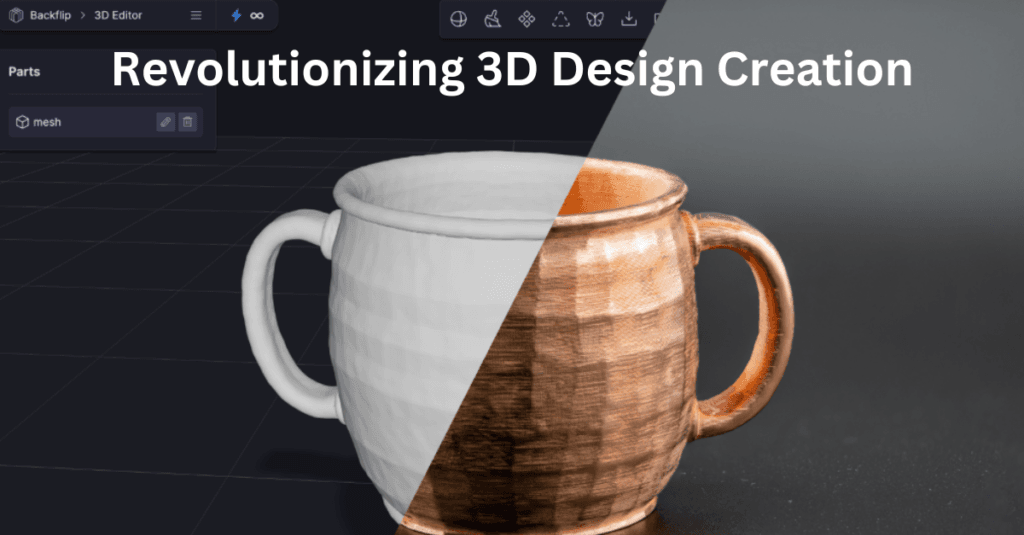Backflip AI has entered the spotlight with its goal to reshape 3D design. After emerging from stealth mode with a $30 million funding round, this startup aims to speed up the creation of physical products using AI-driven tools. In a world that demands rapid prototyping and precise engineering, Backflip AI makes the leap from idea to reality faster and simpler.
How Backflip AI Works
Backflip AI transforms text, sketches, and photos into printable 3D models. The platform’s simple interface allows users with no prior 3D modeling experience to create designs. By describing an object, uploading a sketch, or taking a photo, users can generate high-resolution models ready for printing in materials such as metal, plastic, or carbon fiber.
The standout feature of Backflip AI is its proprietary neural representation. This approach enables the platform to think in three dimensions, producing faster responses and sharper models than conventional tools. By reducing trial and error, Backflip AI allows users to focus more on refining ideas rather than wrestling with complex software.
Applications for Engineers and Designers
Backflip AI appeals to a broad audience. Engineers can use it to prototype machine parts or medical devices, while designers can create detailed models for products or architecture. Its ability to handle functional and artistic designs makes it a valuable tool across industries.
For example, an engineer developing a medical device part can describe its function and materials to generate an initial design. This saves hours compared to traditional CAD tools. Similarly, a furniture designer can upload a sketch and quickly turn it into a printable 3D model, ready for production.
Advantages of Backflip AI
Backflip AI’s primary strengths are speed and simplicity. Traditional design tools often require extensive training and hours of work. Backflip AI compresses this timeline, enabling users to create detailed designs within minutes.
Its accessibility is another advantage. Beginners can experiment without being overwhelmed, while professionals can enjoy its accuracy and adaptability. The tool bridges the gap between user-friendly design and technical capability, making it appealing to a wide range of users.
The platform also supports various inputs, from text prompts to photos. This flexibility allows users to create without mastering complicated software, fostering experimentation and broadening the possibilities of 3D design.
Early Feedback and Challenges
While Backflip AI has generated excitement, it faces challenges. Early users praise its interface and speed but have flagged areas for improvement. For instance, the absence of an undo feature in its editor can be inconvenient. Additionally, while the tool excels in converting 2D inputs to models, the results for complex designs can sometimes vary.
Compared to competitors like Nvidia’s Magic3D and Spare Parts 3D’s Théia, Backflip AI holds an edge with its high-resolution, functional outputs. However, ongoing refinements will be crucial to maintaining its competitive position.
What Lies Ahead
Backflip AI plans to roll out updates aimed at improving precision and user control. Features such as enhanced editing tools and sharper models are in development, directly addressing feedback from early adopters.
The founders have a larger vision that goes beyond individual users. By simplifying 3D design workflows, they aim to revitalize manufacturing processes and inspire creators to push boundaries in engineering and design.
Backflip AI is setting a new standard for 3D design. Whether you’re an experienced engineer or just curious about the field, this platform offers a chance to explore new possibilities. Join during its trial phase, test its features, and see how it can elevate your projects or work.
The Founders and Their Vision
Greg Mark and David Benhaim, the founders of Backflip AI, are veterans in the field. Over ten years ago, they co-founded Markforged, a company that brought 3D printing solutions to industries such as aerospace and robotics. Their efforts led to a public listing and a peak valuation of $2.1 billion. With Backflip AI, they’re focusing on AI-powered tools that reduce design time and enhance creativity.
Their mission is straightforward: provide both engineers and designers with tools to create functional 3D models easily. Combining their knowledge of 3D printing and software, they’ve created a platform that balances precision with usability.

